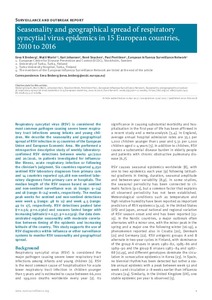Seasonality and geographical spread of respiratory syncytial virus epidemics in 15 European countries, 2010 to 2016
Waris M; Johansen K; Penttinen P; Snacken R; Broberg EK
Seasonality and geographical spread of respiratory syncytial virus epidemics in 15 European countries, 2010 to 2016
Waris M
Johansen K
Penttinen P
Snacken R
Broberg EK
EUR CENTRE DIS PREVENTION & CONTROL
Julkaisun pysyvä osoite on:
https://urn.fi/URN:NBN:fi-fe2021042718899
https://urn.fi/URN:NBN:fi-fe2021042718899
Tiivistelmä
Respiratory syncytial virus (RSV) is considered the most common pathogen causing severe lower respiratory tract infections among infants and young children. We describe the seasonality and geographical spread of RSV infection in 15 countries of the European Union and European Economic Area. We performed a retrospective descriptive study of weekly laboratory-confirmed RSV detections between weeks 40/2010 and 20/2016, in patients investigated for influenzalike illness, acute respiratory infection or following the clinician's judgment. Six countries reported 4,230 sentinel RSV laboratory diagnoses from primary care and 14 countries reported 156,188 non-sentinel laboratory diagnoses from primary care or hospitals. The median length of the RSV season based on sentinel and non-sentinel surveillance was 16 (range: 9-24) and 18 (range: 8-24) weeks, respectively. The median peak weeks for sentinel and non-sentinel detections were week 4 (range: 48 to 11) and week 4.5 (range: 49 to 17), respectively. RSV detections peaked later (r = 0.56; p = 0.0360) and seasons lasted longer with increasing latitude (r = 0.57; p = 0.0329). Our data demonstrated regular seasonality with moderate correlation between timing of the epidemic and increasing latitude of the country. This study supports the use of RSV diagnostics within influenza or other surveillance systems to monitor RSV seasonality and geographical spread.
Kokoelmat
- Rinnakkaistallenteet [19207]
